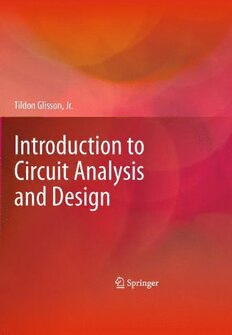Download Introduction to Circuit Analysis and Design PDF Free - Full Version
Download Introduction to Circuit Analysis and Design by Tildon H. Glisson (auth.) in PDF format completely FREE. No registration required, no payment needed. Get instant access to this valuable resource on PDFdrive.to!
About Introduction to Circuit Analysis and Design
Introduction to Circuit Analysis and Design takes the view that circuits have inputs and outputs, and that relations between inputs and outputs and the terminal characteristics of circuits at input and output ports are all-important in analysis and design. Two-port models, input resistance, output impedance, gain, loading effects, and frequency response are treated in more depth than is traditional. Due attention to these topics is essential preparation for design, provides useful preparation for subsequent courses in electronic devices and circuits, and eases the transition from circuits to systems.The differences in depth of treatment arise from a focus on teaching analysis as preparation for design, where the devil is in the details. Introduction to Circuit Analysis and Design gives due attention to differences between physical circuits or devices and circuit or device models, including variation of resistance and capacitance with temperature, variation of resistance with frequency, parasitic and stray capacitance and inductance, residual effects such as leakage resistance of capacitors and winding resistance of inductors, and other such things either not covered or barely mentioned in other books. The treatment of operational amplifiers goes well beyond the ideal model, covering topics such as gain-bandwidth product, slew rate, bias-current compensation, output swing, and power dissipation, all of which must be considered in any realistic design. Where appropriate, chapters conclude with a section that discusses implications for and applications to design.
Detailed Information
| Author: | Tildon H. Glisson (auth.) |
|---|---|
| Publication Year: | 2011 |
| ISBN: | 9789048194421 |
| Pages: | 785 |
| Language: | English |
| File Size: | 7.07 |
| Format: | |
| Price: | FREE |
Safe & Secure Download - No registration required
Why Choose PDFdrive for Your Free Introduction to Circuit Analysis and Design Download?
- 100% Free: No hidden fees or subscriptions required for one book every day.
- No Registration: Immediate access is available without creating accounts for one book every day.
- Safe and Secure: Clean downloads without malware or viruses
- Multiple Formats: PDF, MOBI, Mpub,... optimized for all devices
- Educational Resource: Supporting knowledge sharing and learning
Frequently Asked Questions
Is it really free to download Introduction to Circuit Analysis and Design PDF?
Yes, on https://PDFdrive.to you can download Introduction to Circuit Analysis and Design by Tildon H. Glisson (auth.) completely free. We don't require any payment, subscription, or registration to access this PDF file. For 3 books every day.
How can I read Introduction to Circuit Analysis and Design on my mobile device?
After downloading Introduction to Circuit Analysis and Design PDF, you can open it with any PDF reader app on your phone or tablet. We recommend using Adobe Acrobat Reader, Apple Books, or Google Play Books for the best reading experience.
Is this the full version of Introduction to Circuit Analysis and Design?
Yes, this is the complete PDF version of Introduction to Circuit Analysis and Design by Tildon H. Glisson (auth.). You will be able to read the entire content as in the printed version without missing any pages.
Is it legal to download Introduction to Circuit Analysis and Design PDF for free?
https://PDFdrive.to provides links to free educational resources available online. We do not store any files on our servers. Please be aware of copyright laws in your country before downloading.
The materials shared are intended for research, educational, and personal use in accordance with fair use principles.

